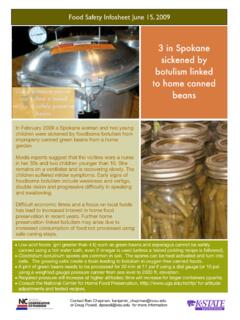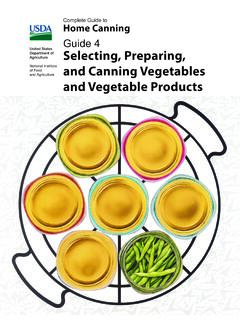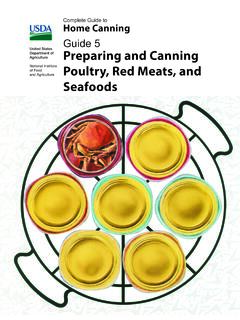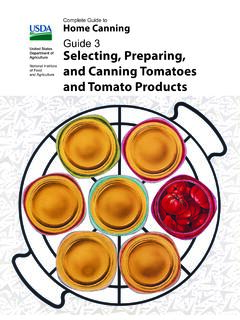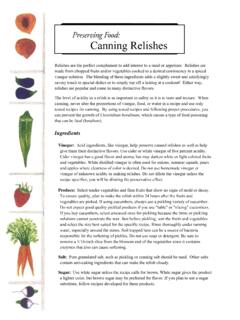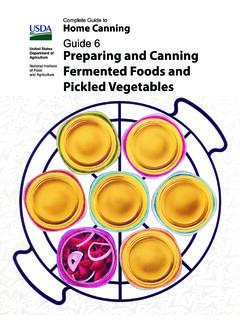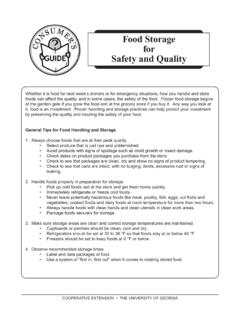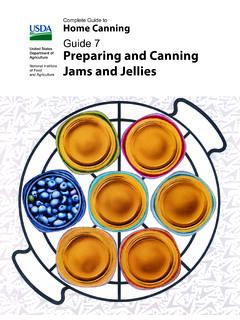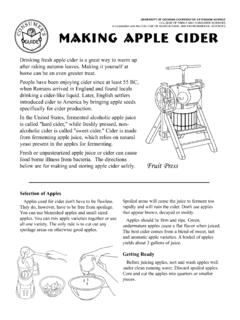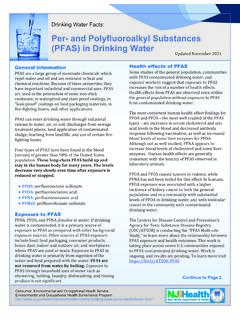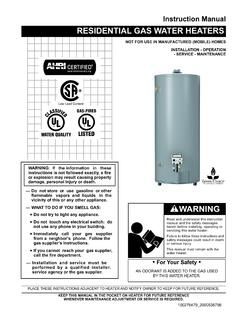Transcription of Complete Guide to Home Canning - University of Georgia
1 Complete Guide toHome CanningAgriculture InformationBulletin No. 539 Revised 2015 AcknowledgmentsThe creation of an Extension Service Center for Excellence at the Penn State University in the 1980s made it possible to conduct the research necessary to revise four previously published bulletins for Canning foods in the home . The Center was the cooperative effort of the Extension Service, Cooperative State Research Service, and the Penn State University with Gerald D. Kuhn, PhD, of the Penn State University as Director. A National Center for home Food Processing and Preservation was established in 2000 as a cooperative effort of the National Institute of Food and Agriculture (formerly the Cooperative State Research, Education, and Extension Service) and the University of Georgia as the lead institution in a multi-state activity with Elizabeth L.
2 Andress, PhD, as Project Director. This Center conducted research that made it possible to include some new products in this revised National Institute of Food and Agriculture wishes to credit the primary development of this Guide to Gerald D. Kuhn (Penn State University ), Elizabeth L. Andress ( University of Georgia ), and Thomas S. Dimick (Penn State University ). USDA staff who assisted in preparing the original Complete Guide to home Canning include Milton P. Baldauf, Catherine E. Adams, Nancy T. Sowers, and Vincent G. Hughes. Others who have assisted in later revisions include Kenneth N. Hall ( University of Connecticut), Thomas W. Poore (USDA), Judy A. Harrison, Elaine M. D sa and Mark A. Harrison (all at the University of Georgia ). Research for the smoked fish recommendation was conducted by Carolyn Raab and Ken Hilderbrand (Oregon State University ) with partial funding from the OSU Extension Sea Grant Program.
3 Research for the fish in quart jars recommendation was conducted by Kristy Long and Chuck Crapo ( University of Alaska). Research for six of the salsa recommendations was conducted by Richard H. Dougherty and Virginia N. Hillers (Washington State University ). The research on acidification of home canned Asian pears and figs was conducted by Margy Woodburn (Oregon State University ). All have contributed significant ideas and time in making this Guide a truly up-to-date research-based project was partially funded through a grant from the National Integrated Food Safety Initiative (Grant No. 00-51110-9762) of the National Institute of Food and Agriculture, Department of 2009 Revised 2015iComplete Guide toHome CanningCaution: All home -canned foods should be canned according to the procedures in this Guide .
4 Low-acid and tomato foods not canned according to the recommendations in this publication or according to other USDA-endorsed recommendations pres-ent a risk of botulism. If it is possible that any deviation from the USDA-endorsed methods occurred, to prevent the risk of botulism, low-acid and tomato foods should be boiled in a saucepan before consuming even if you detect no signs of spoilage. At altitudes below 1,000 ft, boil foods for 10 minutes. Add an additional minute of boiling time for each additional 1,000 ft elevation. However, this is not intended to serve as a recommendation for consuming foods known to be significantly underprocessed according to current standards and recommended methods. It is not a guarantee that all possible defects and hazards with non-recommended methods can be overcome by this boiling process.
5 The recommendation is to only can low-acid and tomato foods according to the procedures in this to commercial products and services is made with the understanding that no discrimination is intended and no endorse-ment by the Department of Agriculture is implied. Clear Jel and Splenda are mentioned because they are the only suitable products presently available to the general public for the stated purposes in given products. The Department of Agriculture (USDA) prohibits discrimination in all its programs and activities on the basis of race, color, national origin, age, disability, and where applicable, sex, marital status, familial status, parental status, religion, sexual orientation, genetic information, political beliefs, reprisal, or because all or part of an individual s income is derived from any public assistance program.
6 (Not all prohib-ited bases apply to all programs.) Persons with disabilities who require alternative means for communication of program information (Braille, large print, audiotape, etc.) should contact USDA s TARGET Center at 202-720-2600 (voice and TDD). To file a complaint of discrimination,write to USDA, Director, Office of Civil Rights, 1400 IndependenceAvenue, , Washington, DC 20250-9410, or call 800-795-3272(voice) or 202-720-6382 (TDD). USDA is an equal opportunity providerand 539 PrefaceHome Canning has changed greatly in the 180 years since it was introduced as a way to preserve food. Scientists have found ways to produce safer, higher quality products. The first part of this publication explains the scientific principles on which Canning techniques are based, discusses Canning equipment, and describes the proper use of jars and lids.
7 It describes basic Canning ingredients and procedures and how to use them to achieve safe, high-quality canned products. Finally, it helps you decide whether or not and how much to can. The second part of this publication is a series of Canning guides for specific foods. These guides offer detailed directions for making sugar syrups; and for Canning fruits and fruit products, tomatoes and tomato products, vegetables, red meats, poultry, seafoods, and pickles and relishes. Handy guidelines for choosing the right quantities and quality of raw foods accompany each set of directions for fruits, tomatoes, and vegetables. Most recipes are designed to yield a full canner load of pints or quarts. Finally, processing adjustments for altitudes above sea level are given for each food. This publication contains many new research-based recommendations for Canning safer and better quality food at home .
8 It is an invaluable resource book for persons who are Canning food for the first time. Experienced canners will find updated information to help them improve their Canning is continually being conducted in areas that affect food preservation recommendations. Make sure your food preservation information is always current with up-to-date tested publication supersedes four USDA home and Garden Bulletins: Number 8 home Canning of Fruits and Vegetables ; Number 56 How to Make Jellies, Jams, and Preserves at home ; Number 92 Making Pickles and Relishes at home ; and Number 106 home Canning of Meat and Poultry. iiiiiFor Safety s SakePressure Canning is the only recommended method for Canning meat, poultry, seafood, and vegetables. The bacterium Clostridium botulinum is destroyed in low-acid foods when they are processed at the correct time and pressure in pressure canners.
9 Using boiling water canners for these foods poses a real risk of botulism Clostridium botulinum bacteria survive and grow inside a sealed jar of food, they can produce a poisonous toxin. Even a taste of food containing this toxin can be fatal. Boiling food 10 minutes at altitudes below 1,000 ft should destroy this poison when it is present. For altitudes at and above 1,000 ft, add 1 additional minute per 1,000 ft additional elevation. Caution: To prevent the risk of botulism, low-acid and tomato foods not canned according to the recommendations in this pub-lication or according to other USDA-endorsed recommendations should be boiled as above, in a saucepan before consuming, even if you detect no signs of spoilage. This is not intended to serve as a recommendation for consuming foods known to be significantly underprocessed according to current standards and recommended methods.
10 It is not a guarantee that all possible defects and hazards with other methods can be overcome by this boiling process. All low-acid foods canned according to the approved recommendations may be eaten without boiling them when you are sure of all the following: Food was processed in a pressure canner. Gauge of the pressure canner was accurate. Up-to-date researched process times and pressures were used for the size of jar, style of pack, and kind of food being canned. The process time and pressure recommended for sterilizing the food at your altitude was followed. Jar lid is firmly sealed and concave. Nothing has leaked from jar. No liquid spurts out when jar is opened. No unnatural or off odors can be Your Canned Foods Pass This Test?Overall appearance Good proportion of solid to liquid Full pack with proper headspace Liquid just covering solid Free of air bubbles Free of imperfections stems, cores, seeds Good seals Practical pack that is done quickly and easilyFruit and vegetables Pieces uniform in size and shape Characteristic, uniform color Shape retained not broken or mushy Proper maturityLiquid or syrup Clear and free from sedimentDetermining Your Altitude Above Sea LevelIt is important to know your approximate elevation or altitude above sea level in order to determine a safe processing time for canned foods.
